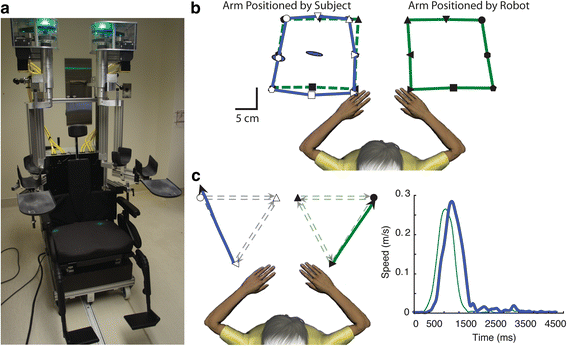A composite robotic-based measure of upper limb proprioception
- PMID: 29132388
- PMCID: PMC5683446
- DOI: 10.1186/s12984-017-0329-8
A composite robotic-based measure of upper limb proprioception
Abstract
Background: Proprioception is the sense of the position and movement of our limbs, and is vital for executing coordinated movements. Proprioceptive disorders are common following stroke, but clinical tests for measuring impairments in proprioception are simple ordinal scales that are unreliable and relatively crude. We developed and validated specific kinematic parameters to quantify proprioception and compared two common metrics, Euclidean and Mahalanobis distances, to combine these parameters into an overall summary score of proprioception.
Methods: We used the KINARM robotic exoskeleton to assess proprioception of the upper limb in subjects with stroke (N = 285. Mean days post-stroke = 12 ± 15). Two aspects of proprioception (position sense and kinesthetic sense) were tested using two mirror-matching tasks without vision. The tasks produced 12 parameters to quantify position sense and eight to quantify kinesthesia. The Euclidean and Mahalanobis distances of the z-scores for these parameters were computed each for position sense, kinesthetic sense, and overall proprioceptive function (average score of position and kinesthetic sense).
Results: A high proportion of stroke subjects were impaired on position matching (57%), kinesthetic matching (65%), and overall proprioception (62%). Robotic tasks were significantly correlated with clinical measures of upper extremity proprioception, motor impairment, and overall functional independence. Composite scores derived from the Euclidean distance and Mahalanobis distance showed strong content validity as they were highly correlated (r = 0.97-0.99).
Conclusions: We have outlined a composite measure of upper extremity proprioception to provide a single continuous outcome measure of proprioceptive function for use in clinical trials of rehabilitation. Multiple aspects of proprioception including sense of position, direction, speed, and amplitude of movement were incorporated into this measure. Despite similarities in the scores obtained with these two distance metrics, the Mahalanobis distance was preferred.
Keywords: Kinesthesia; Outcome measure; Position sense; Proprioception; Robotics; Stroke; Upper extremity.
Conflict of interest statement
Ethics approval and consent to participate
This research was approved by the University of Calgary Conjoint Health Research Ethics Board (#22123). All subjects provided written informed consent prior to study participation.
Consent for publication
Not applicable
Competing interests
Stephen H. Scott is cofounder and chief scientific officer of BKIN Technologies, the company that commercializes the KINARM robotic device used in this study. All other authors have no competing interests.
Publisher’s Note
Springer Nature remains neutral with regard to jurisdictional claims in published maps and institutional affiliations.
Figures



Similar articles
-
Vision of the upper limb fails to compensate for kinesthetic impairments in subacute stroke.Cortex. 2018 Dec;109:245-259. doi: 10.1016/j.cortex.2018.09.022. Epub 2018 Oct 11. Cortex. 2018. PMID: 30391879
-
Relative independence of upper limb position sense and reaching in children with hemiparetic perinatal stroke.J Neuroeng Rehabil. 2021 May 12;18(1):80. doi: 10.1186/s12984-021-00869-5. J Neuroeng Rehabil. 2021. PMID: 33980254 Free PMC article.
-
Anatomical correlates of proprioceptive impairments following acute stroke: a case series.J Neurol Sci. 2014 Jul 15;342(1-2):52-61. doi: 10.1016/j.jns.2014.04.025. Epub 2014 Apr 27. J Neurol Sci. 2014. PMID: 24819922
-
Upper Extremity Proprioception After Stroke: Bridging the Gap Between Neuroscience and Rehabilitation.J Mot Behav. 2017 Jan-Feb;49(1):27-34. doi: 10.1080/00222895.2016.1219303. Epub 2016 Oct 11. J Mot Behav. 2017. PMID: 27726645 Review.
-
Effect of functional electrical stimulation on the proprioception, motor function of the paretic upper limb, and patient quality of life: A case report.J Hand Ther. 2016 Oct-Dec;29(4):507-514. doi: 10.1016/j.jht.2016.06.012. Epub 2016 Sep 21. J Hand Ther. 2016. PMID: 27665394 Review.
Cited by
-
Assessing kinesthetic proprioceptive function of the upper limb: a novel dynamic movement reproduction task using a robotic arm.PeerJ. 2021 May 3;9:e11301. doi: 10.7717/peerj.11301. eCollection 2021. PeerJ. 2021. PMID: 33987004 Free PMC article.
-
Towards a Platform for Robot-Assisted Minimally-Supervised Therapy of Hand Function: Design and Pilot Usability Evaluation.Front Bioeng Biotechnol. 2021 Apr 15;9:652380. doi: 10.3389/fbioe.2021.652380. eCollection 2021. Front Bioeng Biotechnol. 2021. PMID: 33937218 Free PMC article.
-
Aging increases proprioceptive error for a broad range of movement speed and distance estimates in the upper limb.Front Hum Neurosci. 2023 Oct 11;17:1217105. doi: 10.3389/fnhum.2023.1217105. eCollection 2023. Front Hum Neurosci. 2023. PMID: 37886690 Free PMC article.
-
Proprioception and motor performance after stroke: An examination of diffusion properties in sensory and motor pathways.Hum Brain Mapp. 2019 Jul;40(10):2995-3009. doi: 10.1002/hbm.24574. Epub 2019 Mar 19. Hum Brain Mapp. 2019. PMID: 30891844 Free PMC article.
-
Test-retest reliability of the KINARM end-point robot for assessment of sensory, motor and neurocognitive function in young adult athletes.PLoS One. 2018 Apr 24;13(4):e0196205. doi: 10.1371/journal.pone.0196205. eCollection 2018. PLoS One. 2018. PMID: 29689075 Free PMC article.
References
-
- Fugl-Meyer AR, Jaasko L, Leyman I, Olsson S, Steglind S. The post-stroke hemiplegic patient. Scand J Rehab Med. 1975;7:13–31. - PubMed
-
- Brott T, Adams HP, Olinger CP, Marler JR, Barsan WG. Biller J, et al. A Clinical Examination Scale. Stroke: Measurements of Acute Cerebral Infarction; 1989. - PubMed
-
- Gowland C, Stratford P, Ward M, Moreland J, Torresin W, Van Hullenaar S, et al. Measuring physical impairment and disability with the Chedoke-McMaster stroke assessment. Stroke 1993;24:58–63. - PubMed
-
- Meyer S, Karttunen AH, Thijs V, Feys H, Verheyden G. How do somatosensory deficits in the arm and hand relate to upper limb impairment, activity, and participation problems after stroke? A Systematic Review Phys Ther. 2014;94:1220–1231. - PubMed
MeSH terms
Grants and funding
LinkOut - more resources
Full Text Sources
Other Literature Sources
Medical

